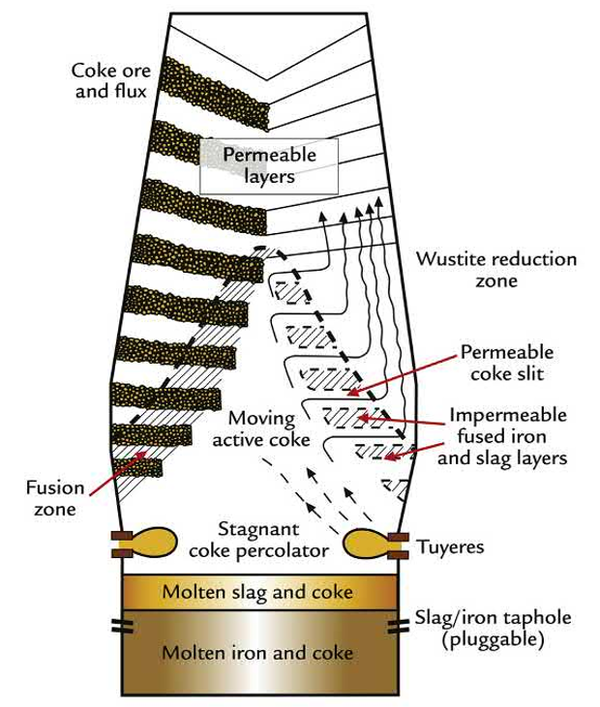Simulation of Flow and Packing Behavior of Multi-Component Particle Mixtures
Research of Raïsa Roeplal
Introduction and problem definition
Steel is the most important engineering and construction material worldwide. The majority of energy consumed in a steel production facility is attributed to the smelting unit, a tower commonly known as a blast furnace where molten iron is produced through a series of mostly endothermic chemical reactions occurring between ascending hot air (injected through nozzles at the bottom of the furnace) and a descending packed bed of raw materials (mainly coke and iron-bearing materials), which is assembled by charging the materials in alternating layers at the top of the furnace. Since the air temperature is highest at the nozzles, the burden materials are progressively heated towards to bottom of the furnace and eventually reach their melting points at different tower depths. The extraction of liquid products allows the packed bed to continuously travel downwards and a new batch of raw materials is added once the stock line level has decreased to a set-point height. Thus, the blast furnace can be regarded as a continuous counter-current reactor in which the solid-gas interactions control the process.
The layered burden structure (cf. Figure 1) is perhaps the most important factor in process efficiency and stability. Firstly, the coke particles maintain their solid structure at higher temperatures than iron ore particles, thereby providing permeable material layers at lower furnace depths than the iron layers which become impermeable and obstruct the ascending gas flow. Secondly, in the upper furnace regions, the heat exchange between descending solids and ascending gases determines all important thermo-chemical processes required for iron melting. One of the most important factors in this regard is the bed porosity, which directly reflects the permeability. Even a small change in porosity along the vertical axis of the bed has a drastic effect on the permeability, gas distribution, temperature and resulting chemical reactions throughout the bed. Hence, knowledge of the spatio-temporal distribution of raw material constituents, and how this can be controlled, is of particular interest for process optimization. However, despite their existence for many decades, blast furnaces are still poorly understood in terms of the complex, interdependent processes occurring simultaneously during operation and, consequently, identifying the key process parameters which can be controlled and optimized is very challenging. The poor understanding of blast furnace processes requires an in-depth analysis of the system’s behavior as a first step towards systematic optimization.
Objective and approach
The objective of this study is to develop a computational model, using the Discrete Element Method (DEM), which predicts the material behavior in the upper part of the furnace, i.e. during charging and descent in the top layers. More specifically, granular phenomena such as layer build-up, segregation and abrasion - all resulting from interactions between the different raw materials in different flow and stress regimes - will be studied in detail.
The material burden is essentially a dense collection of discrete grains ranging in size, density, shape and surface properties. Materials of this (discrete) nature are commonly known as "granular" matter and they are studied extensively in literature due to the complexity of their collective behavior, which increases considerably with the number of different components making up the granular assembly. Given the scale of the system and the diversity of materials and processes involved therein, the idea is to develop a model which is as simple as possible while capturing the relevant phenomena within the system of interest. Hence, the first step is evaluating the effect of different material properties such as particle size, density and shape on the material behavior. Secondly, the model will be calibrated and subsequently validated experimentally on lab-scale to ensure its accuracy. Next, a scaling approach must be identified in order to implement the model on an industrial scale and finally, the model will be used to investigate how the burden structure can be optimized by means of novel charging control strategies.
Funding
This project is carried out within the larger scope of the "Industrial Dense Granular Flows" Project, where research is performed in a consortium with the following partner companies and academic institutes: TATA Steel Nederland Technology B.V., SABIC Europe B.V., Teijn Aramid B.V., Shell Global Solutions International B.V., Endhoven University of Technology, University of Twente and Delft University of Technology. The research received funding from the Dutch Research Council (NWO) in the framework of the ENW PPP Fund for the topsectors and from the Ministry of Economic Affairs in the framework of the "PPS-Toeslagregeling".
Contact
PhD candidate
ir. Raïsa Roeplal (R.N.Roeplal@tudelft.nl)
Supervisors
Assoc. Prof. Dr. ir. Dingena Schott (D.L.Schott@tudelft.nl) and Dr. ir. Yusong Pang (Y.Pang@tudelft.nl)
